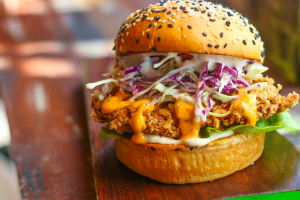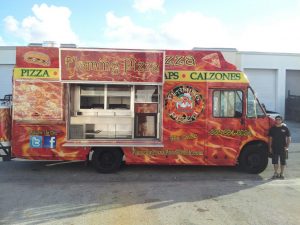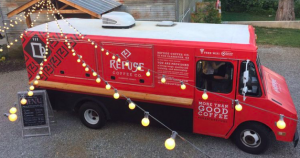Congrats! You’ve made a food product. Whether it’s sauce, dip, brownie mix, or a beverage, it’s a huge accomplishment to see your product hit the shelf on your local grocery store. But, it’s hard to ignore one thing…..
Your product is priced significantly higher than everything else on the shelf.
There’s several dollars between your national competitors – and maybe even other local companies. But, you think – “Well, it’s got to be that high!” Yes, costs are always higher for small manufacturers. And even if big companies replicate your product they could still make it for less than you can. They have buying power – and cash. Cash is king.
You’re not alone.
The specialty food and food truck industry is full of thousands of products with premium price points. It’s rapidly growing into the tens of billions in revenue. I know, you want a piece of that pie, don’t you?
While the category is expanding, that also means you’ve got premium competition.
They’re all competing for your neighbor’s dollar. And some are doing a great job. Tessemae’s All Natural, Ghiradelli, and Jeni’s Ice Cream to name a few. The founders of these companies have figured out how to create a successful business with premium products.
Jeni’s is probably the best example. You can buy a pint of Ben & Jerry’s ice cream for $5.99. Jeni’s? Get ready to throw down $10-12 for the same amount of ice cream. I did and it was the most glorious ice cream ever.
That’s 2x the price of an already-premium priced product. So, what the heck are companies like Jeni’s doing to win over customers and convince them premium products. Here are 5 ways:
1. Look at your competition (specialty)

Gourmet fried chicken burger.
Imitation is the greatest form of flattery. Do what all of these premium brands are already doing — down to their websites, social media, packaging, people, and story. Copy them.
But, keep your own style – your own tone. There may not be a premium competitor locally – or even regionally – so solidify yourself as that player. Go where the cheap companies have never gone before – and do it with some safety net, knowing other companies have been successful.
2. Communicate monetary value
I had a reader pose this question to me (which prompted this post – thanks, Dan!). He makes super-healthy mixes for muffins and brownies and want to know if I had tips to sell a product 4x the price of what was currently on the shelf. My advice? Stress the monetary value of his mixes.
For example, you get 8 muffins for $8.99 (not including the additions you have to mix in). But, if you were to pay for one gluten free muffin in the a bakery you’re going to pay $2.50-$3. If you bought 8, that’s $20-24. Even if you bought the mix-ins brand new, it’s less than $24. Getting something for less is value. Plus, his mixes produce fresh & tasty, muffins. And did I mention you can add chocolate chips whenever you want. I’m in.
3. Show & tell customers why your product is quality

Built by M&R Specialty Trailers and Trucks.
Most customers see two jars of ketchup on the grocery store shelf and say “those are two bottles of ketchup.” One is Heinz. One is gourmet. There’s a $4 difference. But, how does the customer know what makes your ketchup $4 more?
Do you use vine-ripened tomatoes? Are they local tomatoes? And what about your spices (we all know Heinz doesn’t use a complex blend of spices). It’s your job to communicate this to your customers. The challenge? The product in your container can’t speak to your customers. Use your label, your website, and social media to show & tell customers why your product is premium priced.
Using the example of the condiment company Green Mountain Mustard, they are a small Vermont family-owned business. We have expensive flavor profiles — not to mention a completely different texture thanks to eggs and butter. Those are two expensive ingredients that create a premium, luxurious taste.
What about your product? How can you show customers it’s worth its weight in gold?
4. Get customers to help you establish your brand

Built by M&R Specialty Trailers and Trucks.
Your customers are one of your best marketing assets. They already know your product is superior. They already know why. And they’re going to tell their friends and family why they need to purchase your product. You want as many of these people on your “street team” as possible.
The beauty of this strategy? It happens naturally.
Let’s take a look at Jeni’s Ice Cream again. Why does she have national distribution? Probably because her ice cream is awesome. But, also because word has spread. Paying $10-12/pint for her ice cream is 100% worth it. Yes, they have an awesome marketing team, but as they say — “the product speaks for itself”. Customers do the majority of her marketing.
How can you work with your customers to spread your product’s gospel? (That’s for a future post!)
5. Stand firm with your price
Hmmm – what’s this doing here? Well, the only way you’re going to keep your premium position is if you (wait for it) keep your price high. Grocery stores are going to pressure you to bring your price down to what I call “mass-market” prices. Or, the price that’ll likely move the most product.
Even though you may be able to reduce costs on volume, keeping your higher price means super-awesome gross margins. Keep your price high for as long as you can. It’ll help you focus on your premium marketing strategies – even if grocery stores are pressuring you to go lower. Stay firm. Stay confident.
Selling a higher-priced item when your competition charges 3-4 times less on the grocery store is a challenge because it takes a ton of time to build up a “luxury” brand. Hopefully these tips help you not only make a better product, but stay confident in charging the price you charge.
What strategies have you used to convince consumers your premium product is worth their hard-earned dollars? Let me know in the comments below!

Leave A Comment